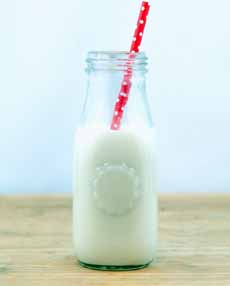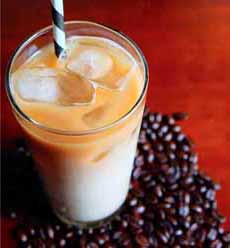TIP OF THE DAY: Homemade Ice Cream Sandwiches & An Ice Cream Sandwich Social
 Adapt the concept of an ice cream social to a DIY ice cream sandwich social (photo courtesy King Arthur Flour).
An easy way to make coffee milk: Just add coffee syrup, as in this recipe from Cocktail Crafty. |
July is National Ice Cream Month. In our neck of the woods, gourmet ice cream sandwiches have been the rage for a while. What makes them “gourmet,” beyond the super-premium ice cream, is the sandwiching—usually homemade cookies in chocolate chip, chocolate chocolate chip, oatmeal, peanut butter and snickerdoodle. When we make our own cookies for homemade ice cream sandwiches, we make chocolate-dipped graham crackers. When people ask what they can bring, we assign them a batch of cookies. There’s plenty of time to invite friends and family for a casual ice cream social* this weekend or next. You set out the fixings, and let guests make their own sandwiches. Then, make up your menu: What beverages go best with ice cream sandwiches? Youngsters might clamor for soft drinks, but coffee and tea, hot and iced, go best. You know your guests: Are they insistent on beer and wine, or would they be happy with an iced coffee—with a shot of vodka or coffee liqueur? Consider these options, each of which can be enjoyed plain or with a shot: Ingredients Per 8-Ounce Glass ________________ *To estimate how many cookies or waffle quarters you’ll need, multiply 2 cookies/sandwich times 2 sandwiches/guest. |
|
|
ICE CREAM SOCIAL HISTORY An ice cream social is a party where people come to eat ice cream. Ice cream socials date back to 18th-century America, long before the dawn of electric freezers—not to mention electric ice cream makers. The ice cream was hand-cranked. While a laborious undertaking, ice cream socials were very popular, traditional gatherings. According to Wikipedia: Many people would guess that vanilla was the first ice cream flavor, but that is far from the case. You have to think back to the origins of ice cream, around 2000 B.C.E. in China, when the first ice cream was made from snow, flavored with fruit syrups. The concept reached the Middle East via traders, and Alexander the Great brought it to Greece after conquering Persia in 331 B.C.E., where it became a treat for the nobility, who had the servants to fetch snow and ice from the mountains and turn it into dessert. The shaved ice and snow were combined with fruit toppings, honey and nuts—the first sundae, perhaps. Vanilla, which originated in Mexico and was used to flavor the cacao drink, didn’t become a flavor in Europe until the 1600s. As in Mexico, only the wealthy could afford it. Thomas Jefferson is credited with introducing vanilla to the United States in the late 1700s. He became familiar with vanilla at the court of King Louis XVI, while serving as U.S. minister to France (from 1785 to 1789). When he returned to the U.S., he brought 200 vanilla beans with him, and his cook had learned to make ice cream. Here’s the history of vanilla.
|
||




